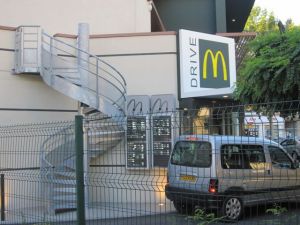Sometimes my purse makes me think that I am carrying around lead weights. I look inside, and I ask myself, “What is so heavy in here?” Emptying the contents on the table, it becomes very clear. Too many coins! Around our house in America, we had a couple of small banks into which one of us emptied our small change. And it’s not the taller one of us. Steve had a bank—a ceramic blue Schnauzer that reminds us of our own by-proxy dog-princess, Scout— on his dresser that I bought for him that managed to collect dust, not coins. I keep a piggy bank in the kitchen for loose coins. Almost every day, I would sort out the pennies, nickels, and dimes and deposit them in the pig, keeping the quarters for use. I would take a bag of coins to the bank periodically and feed them into the counting machine to see how much we had managed to accrue since the last visit.
Here in France, I carry around a lot of coins for a number of reasons. First, there are more coin denominations here, including €1 and €2 coins. Also, des pièces de monnaie (coins) come in handy to deposit in the cups of the beggars who station themselves outside la Poste (post office) and some of the nearby supermarchés that will tolerate their loitering. Also, you need coins to deposit into the distributeurs automatiques de billets (ticket machines) in order to buy a tram ticket. But the real reason that I have some much brass in my purse is because I’ve never been very good about holding onto paper money (what I consider real money) even in America, and all I’m usually left with is spare change.
In Europe, I find the euro to be an interesting phenomenon. Not since the Roman Empire has as many people from so many different countries used a single currency. The name euro was adopted in 1995, and euro coins and notes started circulating January 1, 2002. The euro is the sole currency of 16 EU Member States: Austria, Belgium, Cyprus, Estonia, Finland, France, Germany, Greece, Ireland, Italy, Luxembourg, Malta, the Netherlands, Portugal, Slovakia, Slovenia, and Spain. These countries comprise the Eurozone, some 326 million people in total. In addition, the euro is the official currency of non-EU members Montenegro and Kosovo. And it’s also legal tender in several of Europe’s tiny states, like Vatican City (the Vatican issues its own coins, but it does not issue banknotes), San Marino, and Monaco. Collectively, these countries are known as Euroland.
Euroland uses eight different euro coins from one cent to two euros—1, 2, 5, 10, 20, 50 cents, 1 euro, and 2 euro coins. (Now you see why I have so much change.) All issuing countries use a common reverse, which is the map of Europe and 12 stars that depict Europe as a continent without borders. This differs from the original design that showed the original EU 15-member states outlined as separate countries. (Is this a sign of moving towards real European unity?) Each individual country has its own designs that reflect something about their country on the obverse, such as Leonardo’s Vitruvian Man, one of Italy’s obverse designs. Spain has used a head of Cervantes, Don Quixote‘s author, and the Vatican also issues coins with the current pope’s likeness. At the Euro Information Website, you can pick a country and see images of the bills and the different coins using the menu on the left of the page under the title Euro Notes and Coins.
The bank notes are by far the most colorful pieces of currency that you’ll see around. There are seven denominations from €5 to €500. These include 5, 10, 20, 50, 100, 200 and 500 euro notes. (I’ll probably never actually touch anything above a 50.) Some common features can be found on all of them: the European flag, the initials for the European Central Bank in five versions (BCE, ECB, EZB, EKT, and EKP), the map of Europe, the signature of the ECB president at the time of their issuance, and the word Euro, which for now is in Latin and Greek, but Cyrillic is to be added on new versions. A representation of a building feature from different European architectural periods graces the notes in sequence: Classical–€5, Romanesque–€10, Gothic–€20, Renaissance–€50, Baroque–€100, Iron and Glass–€200 and Modern 20th Century–€500. Each is a different color and size, and holograms are included on the €5 to €20 bills and holographic decals on the €50 and higher denominations.
In addition to all these features, the bills and coins were designed for better use by the sight impaired. There is an intaglio printing (as in die stamping and gravure done from a plate in which the image is sunk below the surface) on the bills that can be felt to make them distinguishable. Adopting different sizes and colors of the bills, and likewise, varying the size and thicknesses of the coins, has made this currency user-friendly.
As we are traveling to many countries in Europe, having a standard European currency makes our traveling a lot easier, so we can skip the currency exchanges when we cross borders. Now our only travel problems are staying under the airline weight limit and not setting off the metal detectors because of all these coins that we carry!
Click on this to see a YouTube video of the scene of the 1972 movie with Liza Minelli & Joel Gray:
Money Makes the World Go ‘Round- from the movie, “Cabaret”









